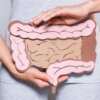
Irritable bowel syndrome (IBS) impacts the lives of between 6-18% of the global population.
While this health condition is not life-threatening, the symptoms of IBS are disruptive and often reduce the quality of life for patients that suffer from this condition.
The symptoms of IBS vary from person to person but include pain related to passing a bowel movement and changes in bowel patterns.
Some with IBS experience irritable bowel syndrome with constipation (IBS-C) and others experience irritable bowel syndrome with diarrhoea (IBS-D).
In addition to this, some with this health condition experience irritable bowel syndrome with mixed bowel movements, alternating between constipation and diarrhoea. (Source: PubMed)
A range of factors can lead to these symptoms of irritable bowel syndrome with diarrhoea (IBS-D) and vary from person to person. This can make it difficult to make guidelines that will work for each person with this condition.
Poor sleep, dietary triggers, high levels of stress and alteration in the beneficial bacteria in the gut can all be underlying factors that contribute to the symptoms of IBS. (Source: PubMed)
Is diarrhea a symptom of irritable bowel syndrome (IBS) and poor gut health?

Alongside IBS-C and IBS-M, IB diarrhoea-predominate IBS is the other main subtype of Irritable Bowel Syndrome. This impacts approximately 1 third of those with IBS.
Due to the unpredictable nature of this subtype of IBS, it can often be the most troubling and life disrupting (Source: PubMed).
When looking at irritable bowel syndrome with diarrhoea (IBS-D) clinically, the Bristol stool chart can be used to clarify and identify what would be considered as diarrhoea.
This accelerated transit time and sudden need to find a toilet can additionally increase levels of stress and contribute to the unsettled aspect of this health condition.
- Type 1 – Separate hard lumps, often difficult to pass and sometimes described as resembling nuts in shape and size.
- Type 2 – A lumpy sausage shape that can also be difficult to pass.
- Type 3 – Sausage-shaped, but with several cracks running across the surface.
- Type 4 – A smooth long snake shape, no cracks or lumps.
- Type 5 – A series of soft blobs with well-defined edges
- Type 6 – Mushy consistency with ragged edges, looking more like a pile than clear separate stools.
- Type 7 – Liquid in form, containing no solid pieces.
Types 5 – 7 would be considered diarrhoea and in some cases can occur with mucus also appearing in the stool

(Source: https://www.ncbi.nlm.nih.gov/pmc/articles/PMC4760857/)
How long can IBS diarrhoea and pain last for?
The frequency of IBS diarrhoea can depend on several factors. One of the main factors is the underlying imbalance in the digestive tract.
If there are imbalances in the gut bacterial that are causing these symptoms of IBS, these symptoms may persist until this is addressed.
Additionally, as stress influences bowel transit time, IBS with diarrhoea may be particularly severe during these more stressful periods of time.
This is particularly relevant for those with anxiety or depression who may be more likely to experience IBS with symptoms of diarrhoea (Source: PubMed).
While there is no set amount of time someone may experience these symptoms, it is common for those with this health condition to go through periods of a flare which on average may last a few days.
What is irritable bowel syndrome
Irritable Bowel Syndrome (IBS) is a health condition that is based on digestive symptoms.
While these symptoms may have underlying causes, for a diagnosis of IBS someone needs to be experiencing a certain degree of digestive symptom.
The criteria that need to be met is called the Rome IV criteria which states.
Recurrent abdominal pain, on average, at least 1 day per week in the last 3 months, associated with two or more of the following criteria:
- Related to defecation
- Associated with a change in frequency of stool
- Associated with a change in form (appearance) of stool.
Criteria fulfilled for the last 3 months with symptom onset at least 6 months before diagnosis (Source: PubMed).
However, while these symptoms may describe the physical symptoms, they do not explain underling issues of IBS.
Underlying issues can be divided into 3 categories.
- Functional Imbalances
- Low grade inflammation
- Bile acid diarrhoea
- Chronic constipation
- Dysbiosis
- SIBO
- Parasitic infection
- Nutritional Factors
- Carbohydrate intolerances
- Lactose intolerance
- Non-coeliac gluten sensitivity
- Vitamin D deficiency
- Lifestyle and Environmental
- Stress
- Circadian disruption
- Physical inactivity

(Source: MDPI)
Other Symptoms of Irritable Bowel Syndrome with diarrhoea (IBS-D) attack
While symptoms of an IBS attack may be unpredictable, each person may be aware of their unique triggers.
As well as the change in bowel patterns, symptoms can include cramping, bloating, abdominal pain, high amounts of gas and well as increased anxiety and low mood.
It may also feel though, even when diarrhoea is being experienced, that the bowels are not fully emptying. However, commonly is IBS symptoms of abdominal pain or intestinal discomfort likely improve following a bowel movement.
(Source: NHS)
Diet for IBS and diarrhoea diet

For anyone with irritable bowel syndrome food and diet can become a big focus. It may also be stressful know what food to eat.
Specific triggers for bloating, cramping or fluctuation in bowel patterns (eg constipation or diarrhoea) can be identified to help manage symptoms of IBS.
However, there is a balance to be struck between when starting with the diet, how restrictive to make it and to address the root cause of IBS symptoms.
A low FODMAP diet is often a helpful approach to food than may help bring symptoms under control. Although, it’s important to remember that just because a food is triggering symptoms, this does not mean the food is the underlying issue in the colon or small intestine.
It more commonly means that there is an imbalance in the digestive system that is allowing a food to trigger symptoms.
While a low FODMAP diet is a common place to begin with identifying common IBS trigger foods, it can often be overly restrictive.
Irritable bowel syndrome foods to avoid
Many find that a low/reduced FODMAP diet helpful for calming IBS symptoms when you’re not experiencing a flare up.
Low FODMAP diet food options include:
- Bell peppers
- Bok choy
- Carrot
- Cherry tomatoes
- Cucumber
- Green beans
- Kale
- Lettuce
- Parsnip
- Spinach
- Aubergine
- Meat
- Poultry
- Fish and Seafood
- Eggs
High FODMAP diet food to limi include:
- Apples
- Pears
- Garlic
- Onion
- Lentils
- Beans
- Cauliflower
- Dried fruit (Source: Monash)
How do I know if my diarrhoea is IBS?
A clear set of symptoms exist to officially diagnose IBS. There are outlined in the ROME criteria.
A diagnosis of IBS-D (Irritable bowel syndrome with diarrhoea) can only be made by a healthcare provider such as a doctor or gastroenterologist. This will also involve excluding the other potential causes of diarrhoea.
These other causes can include:
- Lactose intolerance
- Colorectal cancer
- SIBO
- Low-grade inflammation
- Stress
- Inflammatory bowel disease (Crohn’s disease or Ulcerative colitis) [Source: PubMed]
The symptoms of this condition may appear similar to those seen in IBS-D (Irritable bowel syndrome with diarrhoea), therefore further testing may be an important consideration for many people with the symptoms of diarrhoea we well as abdominal pain and discomfort. [Source: PubMed]
IBS with Diarrhoea Treatment & Gut Health
To address the IBS and symptoms of diarrhoea or abdominal pain, focusing on the gut and underlying imbalances is key to successful treatment.
Patients may be prescribed anti-diarrhoea medication by their doctor such as Loperamide (Imodium). While these can be a very helpful way to manage symptoms and can improve bowel movements and the movement of stool through the colon (intestine), it is unlikely to be addressing the underlying issue or imbalance in the gi tract.
A crucial factor for a successful treatment is to identify and address the cause of the symptoms of IBS-D. [Source: PubMed]
How do I get rid of irritable bowel syndrome with diarrhoea (IBS-D)
Many patients with IBS notice that certain foods can trigger symptoms of IBS and an urgent bowel movement. For example, lactose intolerance is a common issue for many with this condition that triggers the gut symptom of diarrhoea. Lactose intolerance can also leads to abdominal discomfort. (Source: PubMed)
Taking this intolerance as an example, removing this trigger food from the diet can help to resolve or improve symptoms of IBS-D. However, it may not address the underlying health issue in the intestine that is causing the intolerance.
This highlights the role of removing food (or foods) from the diet. It may improve IBS symptoms (which can improve quality of life), but it may not address the underlying issues.
Alongside any removal of trigger foods, addressing the cause of symptoms can also be considered.
This can then be approached with factors such as:






